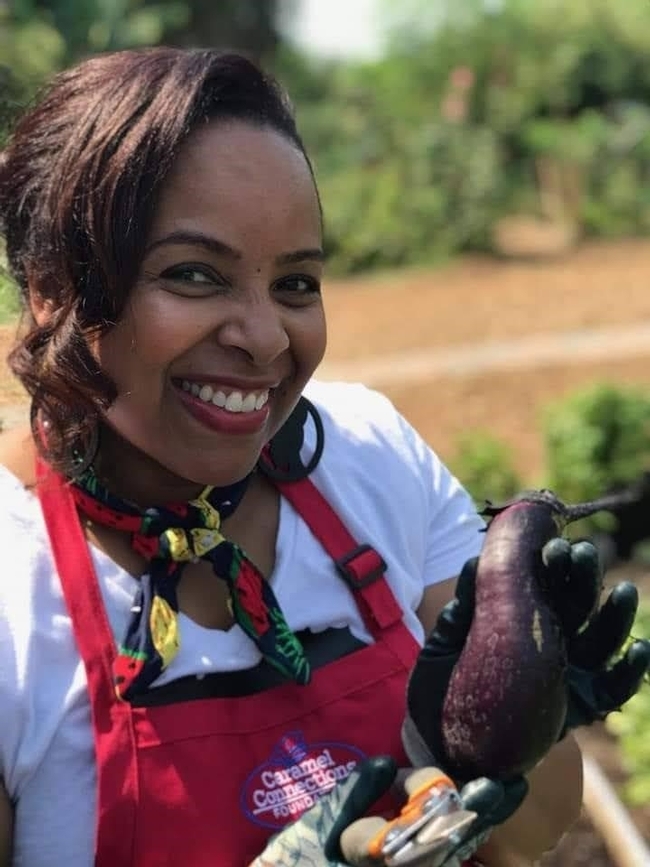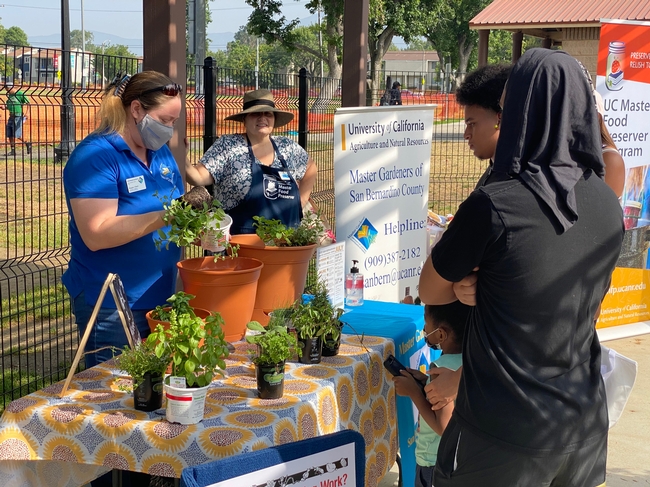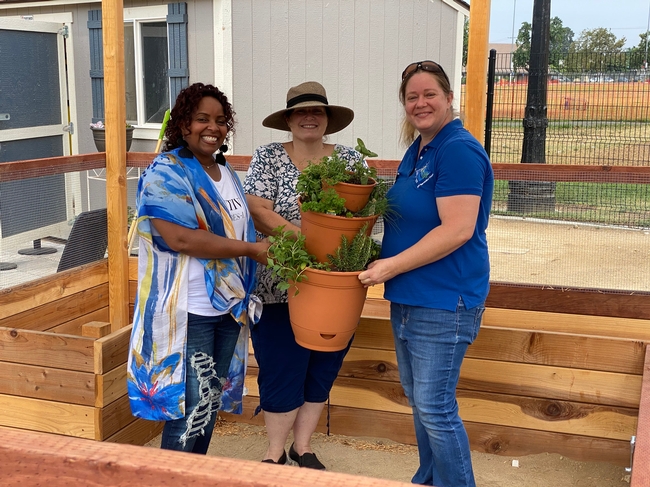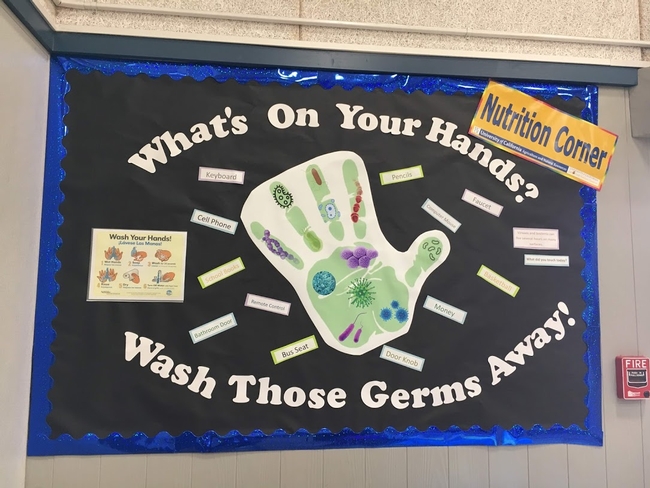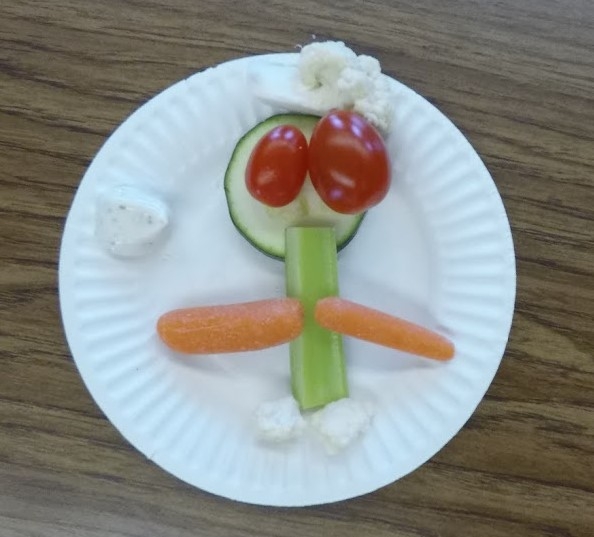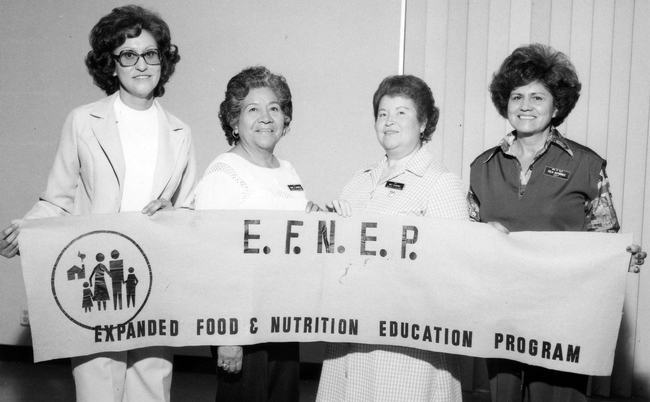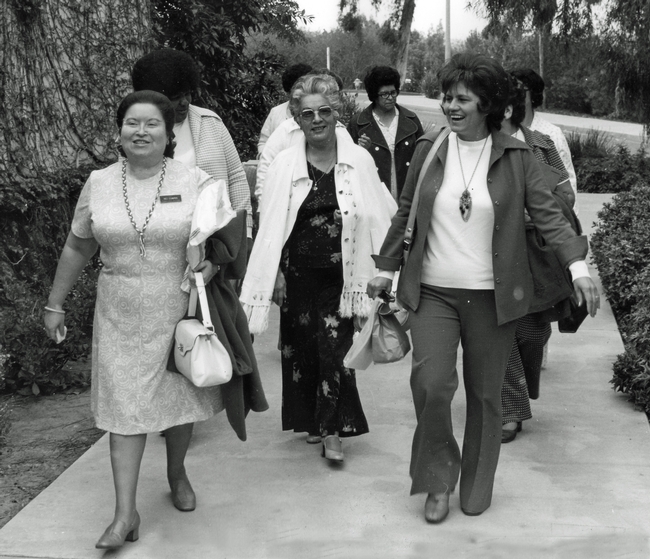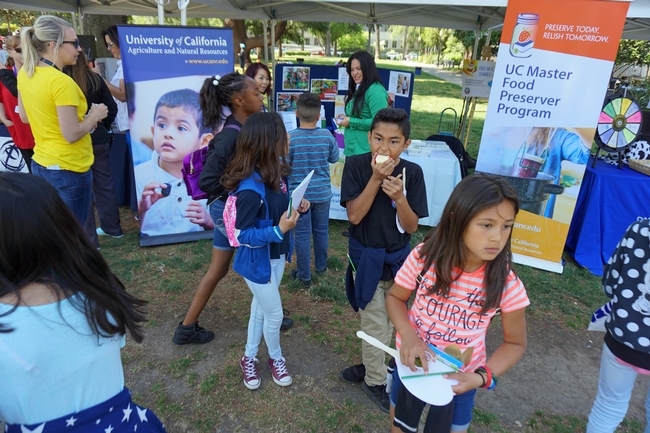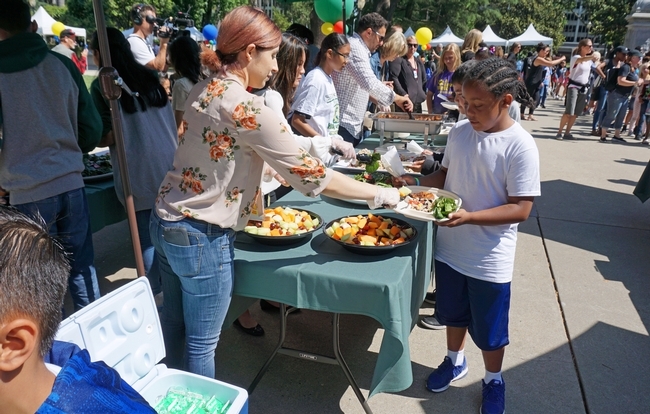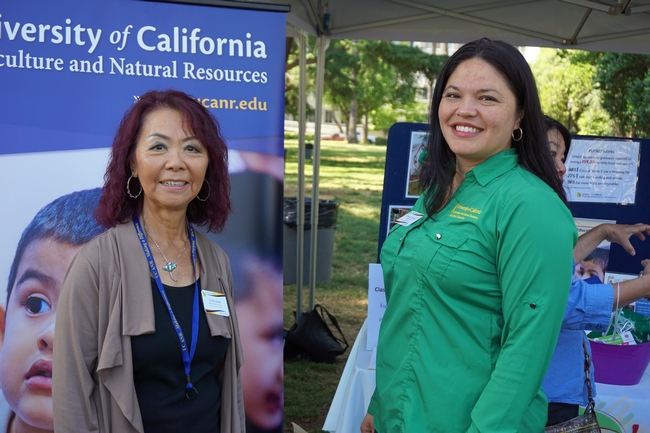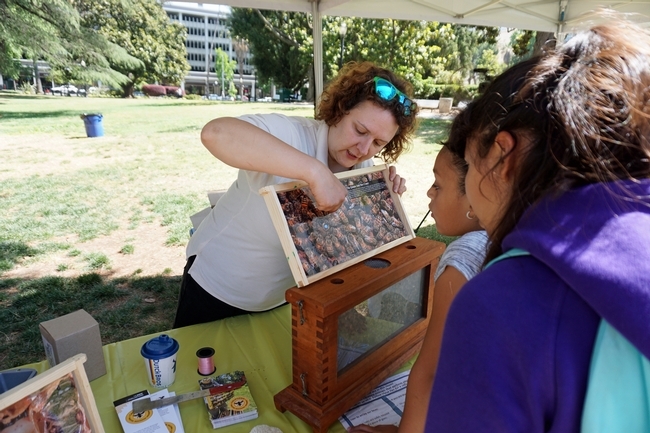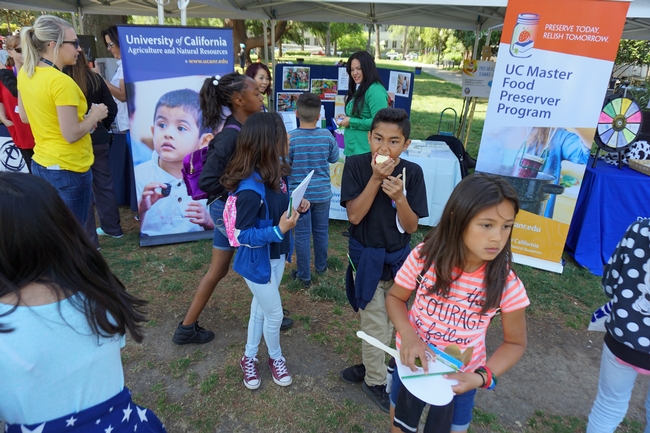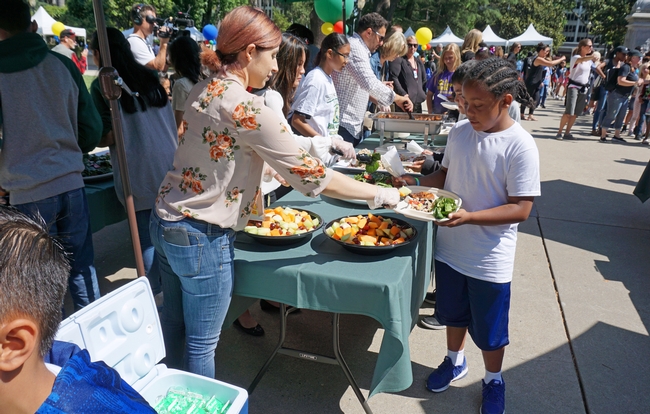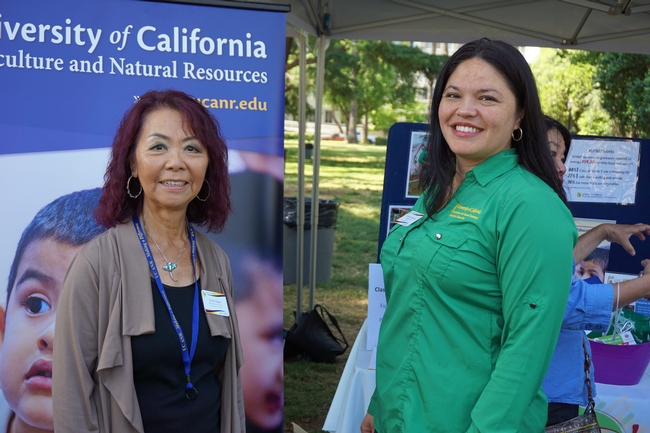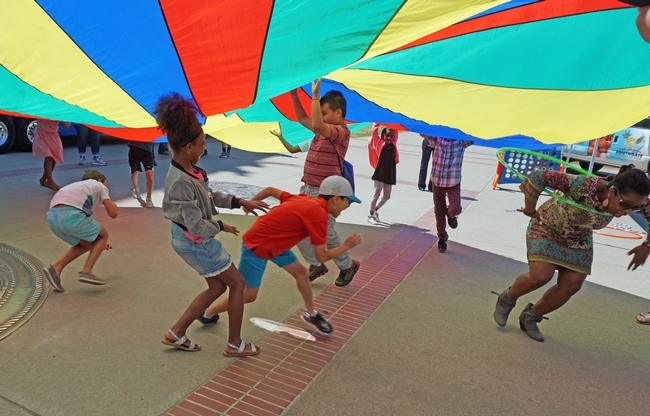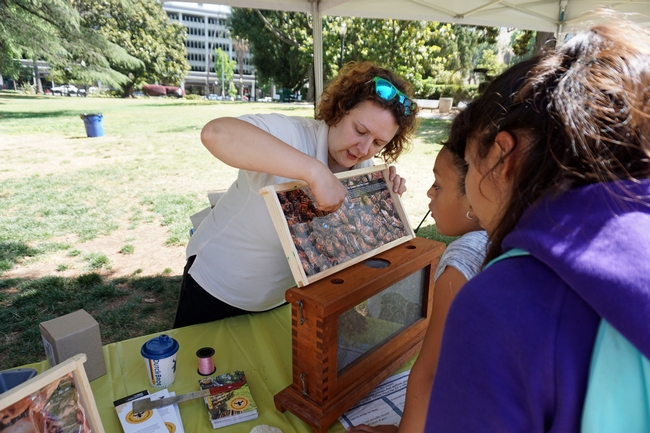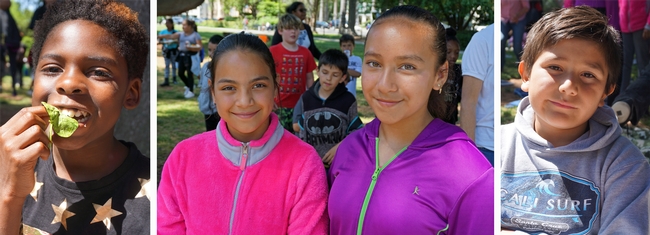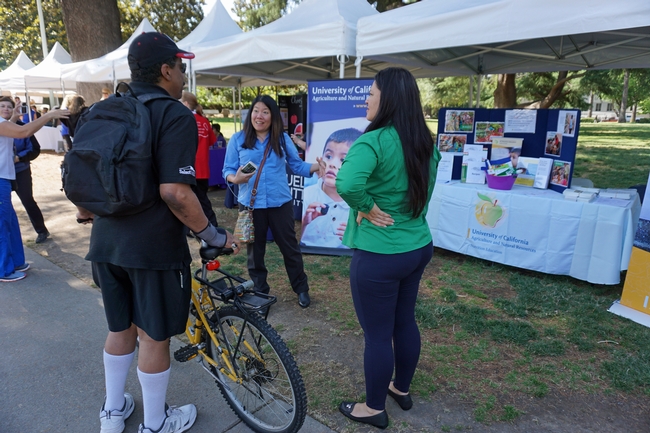Posts Tagged: EFNEP
UC ANR, local nonprofit grow community health in Inland Empire garden
A volunteer recovering from a drug addiction gives time regularly to help stay sober. An older person uses outdoor spaces to stay active, physically and socially, despite mobility issues. And a mother of four strives to teach her children what carrots look like before they become capsules in plastic bags.
While these San Bernardino County residents enjoy their hours within their community garden, the lessons and inspiration they derive travel much farther – forming the branches and roots of a stronger, healthier community.
Hence the name of this unique place in Ontario, the Seeds of Joy Community Garden.
“The goal is to not just grow in the garden, but to grow the community outside the gates as well,” said UC Master Gardener Elizabeth McSwain, whose nonprofit, Caramel Connections Foundation, has nurtured this project from its beginnings in 2018 as a small plot within the Huerta del Valle Garden.
The programs and classes were so well-received that McSwain and her partners and volunteers opened in April 2021 a much larger, 1-acre space within Anthony Muñoz Hall of Fame Park.
As a self-described “green heart with a brown thumb,” McSwain said the success of the garden would not be possible without the support of UC Agriculture and Natural Resources (ANR) staff and volunteers.
McSwain, a restaurant owner, founded Caramel Connections Foundation in 2016 to offer culinary and healthy eating classes at the local Boys & Girls Club. During her first-ever visit to a community garden to attend a “herbs as medicine” class taught by UC Master Gardener Valerie Dobesh, McSwain had a life-changing conversation at an information table.
Maggie O'Neill, the UC Master Gardener program coordinator for UCCE in San Bernardino County, patiently answered McSwain's many questions about the program, which trains volunteers to spread research-based knowledge on home horticulture, pest management and sustainable landscape practices.
“In regards to planting the seed in my heart, I can never say enough about Maggie,” McSwain said, “because Maggie's passion and her knowledge about gardening made me feel like…even though I didn't have the skill set, she made me feel as if I would be a good candidate for the Master Gardener program.”
McSwain graduated from the program in March 2021, equipped with the expertise to better support the volunteers and participants in an ever-blossoming variety of programs that serve a broad swath of the community.
“One of the key founding principles of this garden from the very beginning has been inclusivity and making sure that all community members feel welcome, celebrating many cultures, ethnicities and religions,” O'Neill said. “Elizabeth has made sure that the partners and organizations that are supporting this garden are equally diverse and inclusive so that the community members are able to see themselves represented in the people who are helping to bring this garden together.”
Seeds of Joy now features a Zen garden with succulents to raise drought awareness, a Read in Color Little Free Library emphasizing diverse cultural connections, a composting/vermicomposting bin system to highlight waste diversion (with a small orchard), a story time area for children, an outdoor classroom, a space for yoga classes, and an outdoor community kitchen that helps produce meals for facilities serving individuals and families experiencing homelessness.
“With food insecurity being such a major problem for San Bernardino County in general, even prior to COVID, the current epidemic of poor nutrition in our children is weakening the strength of our community,” McSwain explained. “We hope to play a part in helping to fix that in some way – healthy food and fitness are powerful essentials that are often overlooked.”
Residents of low-income housing units across the street will have priority for reserving plots in the heart of the garden – approximately 30 raised beds for growing fresh, organic produce. Although completion of those beds has been delayed due to COVID impacts, applications have already been coming in.
“Ultimately our goal is to teach Inland Empire families what's involved in maintaining an edible garden,” McSwain said. “We provide them with the basic tools.”
In addition to UC Master Gardener-led classes, other UC ANR programs are contributing to this educational hub within a historically underserved neighborhood. The Master Food Preserver Program volunteers will be offering workshops on how to safely preserve the community garden's harvests, while EFNEP (Expanded Food and Nutrition Program) educators will teach about eating nutritious, delicious food in a budget-conscious way.
“Our programs are a great complement to the garden and to each other because we teach people how to grow their own food, then teach them how to preserve it and how to make lifestyles changes for healthier, happier families,” O'Neill said. “With all of these classes offered free to the community through the UCCE, we are able to add incredible value to an already great project.”
Already, O'Neill has been showing community members how to “companion plant” – maximizing the limited space residents have to work with, by placing ecologically compatible plants next to each other so that they can mutually flourish.
Companion gardening is a fitting analogy for the power of collaboration – with local officials, community and corporate partners, and organizations such as UC ANR – in growing spaces and resources for the benefit of the entire community.
“Partnering with the Master Gardener program and the Master Food Preserver Program and EFNEP is the perfect partnership in that we're all trying to do the same thing,” McSwain said. “We're trying to help people make better choices and to give them the tools so that they can live better lives, and not necessarily have to rely on spending $500 at the grocery store to get organic products, and making a choice between paying your light bills or buying food.”
McSwain welcomes all community members to participate, engage, and visit the Seeds of Joy garden, located at 1240 W. Fourth St. in Ontario.
“I don't want it to be a secret garden,” she said. “We want the community to know that it's there for them, that it's there to enhance their life – to reduce the disparities in our community and to be able to just spark a love of gardening and bring joy.”
In addition to support from UC ANR programs, Seeds of Joy is made possible by the City of Ontario (Mayor Paul Leon, City Council, and former City Manager Al Boling), American Beverage Association, Beola's Southern Cuisine, CalRecycle, Huerta del Valle Garden, Inland Empire Health Plan (IEHP), Inland Empire Resource Conservation District, Kellogg Garden Products, Mercy House, San Bernardino County, SLJ Pro Audio Services – among a host of other community partners.
Creating family home cooking memories with love and gratitude
Growing up in a traditional Asian Indian household, home cooking was a part of the daily routine and a cultural practice. At the time, acquiring cooking knowledge and skills was an expectation and considered normal. When I moved to the United States, I added new knowledge about diverse cultural values and norms surrounding food and home cooking practices.
Today, with millions of people nationwide facing stay-at-home and social distancing guidelines, home cooking has found new meaning for many families. Navigating through this new normal, I feel blessed to have the cooking knowledge and skills that empower me to cook basic pantry food items into diverse cultural food recipes from across the world. Thanks to my family for keeping the passion of home cooking alive.
As the UC Cooperative Extension nutrition, family, and consumer sciences advisor and a researcher trying to understand and identify strategies to support healthy lifestyle habits among children and families, I feel this commitment has never been stronger than it is right now. I decided to meaningfully inform the ways families can work together with children in the kitchen. In this process, I examined the strategies used by UCCE nutrition education programs of Tulare and Kings counties in the past year, along with current research and best practices that promote home cooking, age-appropriate kitchen tasks, and meal preparation activities.
What is cooking and why it matters?
Cooking is a learned skill that is broadly defined as the ability and capacity to prepare meals. Cooking at home is a practice that encompasses a range of activities to include nutrition and age-appropriate kitchen tasks from food planning, preparation, safety, consumption and much more. Children can acquire cooking skills at home with adult guidance and supervision. There are many benefits of cooking at home.
Cooking at home improves health and well-being
Families that prepare meals at home eat a healthier diet. Studies have reported more fruit and vegetable consumption and low consumption of convenience and processed foods among families who cook at home compared to families who cook irregularly or not at all. A study reported that adolescents with cooking ability indicated better nutritional and mental health and stronger family connections. Among adults, cooking at home has indicated improvements in health status, dietary intake, self-efficacy, self-esteem, mood and affect.
Cooking at home strengthens family resource management
Food resource management involves meal planning, shopping, and budgeting. Studies have shown preparing meals at home saves time and money and helps families eat healthy on a budget.
Cooking at home increases family mealtimes
Having basic cooking skills set the foundation for family mealtimes. Research shows when families cook at home, they are more likely to eat at home most days of the week, make healthier food choices, and save money.
Cooking at home promotes family cultural tradition
Families pass on their cultural tradition when they include children in every aspect of the meal preparation, from choosing the food menu and ingredients, to setting the table to making the meal, talking and eating together. Research shows such practices may differ from family to family, however, it creates lifelong knowledge and memories.
Cooking at home contributes to lifelong healthy habits and life skills
Cooking together as a family helps children learn useful life skills of reading, teamwork, planning and organization, communication, problem-solving, creativity, imagination, cleanliness, and gratitude. Children can apply math, science, nutrition, culinary, and geography lessons to understand where the food comes from, how to read a recipe, how to measure ingredients, healthy vs. unhealthy foods, foods from around the world, seasonal foods, nutrition aspects of the food and much more.
Promoting healthy families and communities through UC Cooperative Extension
The University of California Cooperative Extension administers CalFresh Healthy Living, UC and the Expanded Food & Nutrition Education Program in Tulare and Kings counties
Funded by the U.S. Department of Agriculture, nutrition education is an integral component of these programs. Increasingly in recent years, there is a focus on improving lifelong practical skills using age-appropriate learning approaches.
In the past year, the UCCE nutrition programs in Tulare and Kings counties have empowered children, youth, adults, and families with knowledge and skills to make the healthy choice the easy choice.
Participants learned about handwashing and food safety, age-appropriate cooking basics, growing a vegetable garden, reading a recipe, eating healthy from five food groups, healthy and seasonal foods. Through food demonstrations and taste tests, participants enjoyed foods from all food groups, including new fruits and vegetables, and showed a willingness to try them at home.
Additionally, adult learning also included food planning and management, selection, preparation, cooking, and eating on a budget.
How can families engage children in age-appropriate home cooking activities?
Now is the time to create family home cooking memories with love and gratitude
Try a few of the activities listed below, and set goals to adopt small healthy living changes. Soon, you'll be proud and happy to see your children pick up these skills and habits.
Age-appropriate kitchen tasks. Children are great helpers. Parents can delegate and guide children with Age-Appropriate Kitchen Tasks . Age-appropriate tasks are recommended based on what children can do at each age. Effective parental practices can help children stay healthy and safe (Child Development Milestones & Parenting).
Cooking appliances, tools and accessories.Be a kitchen tour guide to your children and help them get to know the kitchen layout and appliances. Show them cooking tools and accessories that you frequently use in the kitchen. Provide age-appropriate cooking tools to encourage children to get involved in the kitchen.
Handwashing. Help children understand the importance of washing hands before, during, and after handling food, cooking, and eating. Help children develop handwashing habits by following Five Steps to Handwashing. Handwashing can be a fun family activity.
Food safety. Explain to children the science behind food handling, cooking, and storage using guidelines about Food Safety in Your Kitchen and Food Safety Fun Learning Family Activities. To get guidance on safe handling, preparation, and storage of food and beverage items, download Foodkeeper App.
Food menu planning. Involve children in Food Planning Activities & Resources. Create a Sample Two-Week Menuto minimize trips to grocery stores. Ask children to help you create a family food menu. During grocery shopping, fill your cart with healthy options and consider shelf-stable and budget-friendly items from each food group with Food Groups Tip for Every Aisle.
Cooking with new foods, herbs and spices.Walk the talk about the importance of eating from five food groups and drinking water instead of sugar-sweetened beverages by doing so yourself. When creating a food menu and food recipes, include foods from five food groups - fruits, vegetables, proteins, grains and dairy from MyPlate and Seasonal Produce Guide. Add flavor to your food with Herbs & Spices. You can also Grow Your Own Herbs & Spices Indoors .
Food recipe cookbooks. Involve children in creating healthy food recipe cookbooks for breakfast, snacks, lunch, appetizers, and dinner. Think about building traditional family food recipes, food recipes from around the world or by culture, quick and easy food recipes, cooking with herbs, slow-cooker recipes, and much more. Family friendly recipe ideas can be found at MyPlate Kitchen, Healthy Recipes from the Whitehouse to You, Meeting Your MyPlate Goals On A Budget, Healthy Eating on a Budget Cookbook.
Food demonstration and taste test. Food demonstration and taste test can be a fun family kitchen activity during weekends. Encourage children to create a fun recipe to cook, and ask them to use their five senses to describe the flavors, ingredients and the food used in the recipe. Try to blend the food from many cultures to create new recipes. Share family food stories with children to keep the family tradition alive.
Family mealtimes. Family mealtime is an opportunity to eat, talk, connect, communicate, and learn. Visit MyPlatePlan to learn what and how much to eat within calorie allowance. Eating together as a family gives the children an opportunity to learn and practice their table manners, social and communication skills.
Reduce food waste. Family meal preparation time is a great opportunity to educate children about how to Recycle & Compost food waste. Recycling food helps save money and reduces the amount of food going to waste.
Food- and kitchen-related COVID-19 informational resources.The USDA Food and Nutrition Service and the Academy of Nutrition and Dietetics has useful nutrition and food safety tips and activities for families managing the challenging conditions of the COVID-19 outbreak. Find these organizations here:
- USDA Food & Nutrition Service Information Link
- Academy of Nutrition & Dietetics Link
- Videos on Kitchen Topics
- Social Media Kitchen Related Topics for Families
- Games, Activities, & Tip Sheets
¡Celebrando 50 años de EFNEP!
Un día, hace poco más de dos décadas, la peruana Nelly Camacho se encontró con una joven inmigrante que buscaba un banco de comida. En la ciudad de Hayward al este del condado de Alameda, la inmigrante acudió a un taller de nutrición de EFNEP en donde se le dio la bienvenida y se le invitó a participar. Titubeando, ella se negó a pasar, aduciendo que no podía aprender pues era analfabeta. “No tienes que saber leer y escribir, puedes mirar y escuchar y así aprenderás a ahorrar dinero en la compra de los alimentos y hacerlos que rindan,” respondió la educadora. La inmigrante no solo aprendió de nutrición, también se sintió orgullosa de sí misma. ‘Es la primera vez, en toda mi vida que recibo un certificado,' recuerda la educadora.
EFNEP o el Programa Ampliado de Educación sobre Alimentos y Nutrición, es uno de los recursos más importantes en la lucha contra la pobreza, desnutrición y obesidad y fue implementado con el propósito de enseñar hábitos alimenticios saludables a los más vulnerables en el país: niños, madres solteras, inmigrantes, desempleados, ancianos y todas aquellas personas que en los vaivenes de la vida enfrentan una situación precaria y sin dinero suficiente para los alimentos.
EFNEP cumple 50 años y en ese lapso las educadoras de nutrición que imparten clases a la comunidad, en escuelas, iglesias y centros comunitarios, han acumulado historias que tocan el corazón. Los protagonistas son mujeres, hombres y niños que han aprendido a llevar una vida sana. Es el caso de un hombre (en el condado de San Joaquín que, a punto de tener una cirugía de corazón, encontró en la alimentación saludable y el ejercicio sus mejores aliados para eludir el bisturí. O el niño en una escuela primaria en el condado de Contra Costa que tras asistir al taller de nutrición olvidó poner en práctica lo aprendido a la hora del almuerzo, pero en cuanto se encontró con su instructor de nutrición comiendo sus verduras le dijo ¡Oh, no tengo ninguna fruta ni verdura!', y entonces corrió a la barra de las ensaladas de la cafetería escolar.
El cambio es parte de un gran esfuerzo nacional cuyas semillas se sembraron a finales de los 1960s.
“EFNEP nació como un programa piloto del Departamento de Agricultura de los Estados Unidos, USDA en 1968 en respuesta a la creciente conciencia del vínculo entre la pobreza y la desnutrición, y sus efectos nocivos sobre los niños de la nación. Desde entonces EFNEP ha buscado influir de manera positiva en la nutrición y la actividad física de las familias de bajos ingresos, en particular las familias con niños pequeños. Además, desde su nacimiento, EFNEP ha usado un modelo innovador de educación que está integrado en las comunidades,” señala Rose Hayden-Smith, asesora de Extensión Cooperativa de la Universidad de California.
La asesora e historiadora, apunta que EFNEP fue concebido como parte del movimiento "Great Society" del presidente Lyndon Johnson que abarcó un ambicioso conjunto de programas a nivel nacional para eliminar la pobreza, aumentar la equidad racial y mejorar el medio ambiente y aunque este programa quedó bajo la dirección del USDA, este no solo se enfocó en las familias rurales sino también en las familias que vivían en las áreas urbanas en crecimiento de la nación. “Dado el éxito de los programas piloto, EFNEP fue financiado permanentemente en 1969, a través de los fondos Smith-Lever, incluidos en la Ley Agrícola de la nación.” sostiene Hayden-Smith.
Así en plena era del Apolo 11 y cuando por primera vez aterrizaba el hombre en la luna, nació EFNEP como un programa, administrado en el Estado Dorado, por Extensión Cooperativa de la Universidad de California, UCCE.
Alameda fue uno los primeros condados donde inició el programa piloto y para su implementación contó con la colaboración de 220 educadoras de nutrición, la mayoría eran amas de casa, quienes recibieron entrenamiento de los expertos de UCCE porque era importante que los educadores fueran parte de la comunidad. “Originalmente se pensó que los expertos de nutrición podían realizar ese programa, pero luego se dieron cuenta que realmente necesitaban personas de la comunidad que conocieran a la comunidad, que pudieran relacionarse con la gente, que hablaran su idioma y que estuvieran conscientes de ciertas sensibilidades culturales. Fue entonces cuando comenzaron a contratar lo que llamaron en aquellos días, educadores de nutrición y designaron en ese momento que estos educadores deberían estar familiarizados con la comunidad y ser modelos a seguir para la comunidad”, narra Mary Blackburn, experta en nutrición de UCCE en Alameda.
EFNEP es considerado actualmente uno de los programas de la salud preventiva de mayor éxito. Investigaciones indican que por cada dólar invertido en el programa de nutrición se ahorra $8.34 en la salud.
“Como educadora de EFNEP trabajé con personas que estaban en un programa de rehabilitación de las drogas y un día entre la quinta o sexta clase, se acercó un hombre y me dijo, ‘Sabe que estoy muy contento de que vino usted a esta clase; yo tengo problemas del corazón, arterías obstruidas, y me habían dicho que iba a necesitar cirugía pero los doctores me dijeron que si sigo con estos cambios podría ser que no necesite la operación,” narró Anna Martin, experta en nutrición en el condado de San Joaquín, quien inició como educadora de EFNEP hace 30 años. “No sé que haya pasado con ese hombre, pero lo importante es el hecho que él aprendió que su salud dependía de los cambios de los que hablamos en clase.”
Cuando EFNEP inició no había herramientas de comunicación tan eficientes como ahora. No se veían computadoras en los hogares, ni celulares en los bolsillos. Entonces las educadoras empezaron tocando puertas en sus vecindarios. “El primer desafío fue conocer a la comunidad y desarrollar la confianza,” señala Martin. “Desarrollar esa confianza significa que necesitas salir y conocer a los directores de los programas. Necesitas trabajar en las ferias de salud. Necesitas poner tu cara, tu nombre y quién eres. Y luego, cuando impartes clases, debes asegurarte que estás cumpliendo siempre de forma coherente, dándole a los participantes un certificado al final y quizás regresar para saber cómo les va.”
¿Eres el educador de nutrición?
EFNEP tiene un programa muy extenso que ha evolucionado para mantenerse relevante para las audiencias que sirve, además continúa siendo un programa comunitario impartido por educadores que viven en las comunidades donde enseñan. “Vivo cerca de las áreas en dónde enseñó. Entonces, pueden verme en las tiendas, cuando estoy comiendo. Ellos saben que soy una persona real en la comunidad y tengo experiencias similares con las que pueden relacionarse,” señala Adán Osoria, educador en Contra Costa.
Osoria, es bilingüe y recién egresado de la universidad y ha asumido el reto de llevar el mensaje de nutrición a estudiantes de primaria y secundaria llenos de energía, no es nada fácil, pero él se las ingenia. “(Los niños) están entusiasmados con lo que están aprendiendo, hablan con sus papás de lo que han aprendido y realmente entregan los folletos que les doy. Y en lugares públicos me han preguntado "Oh, ¿eres el educador de nutrición? Mi hijo siempre habla de esto y de lo que realmente le gusta.”
Actualmente EFNEP cuenta con 35 educadoras de nutrición y los talleres se ofrece en 24 de los 58 condados del estado es programa muy extenso y los educadores deben aprender varias lecciones que llevan nombres atractivos: ¡Coma bien manténgase activo!
“Uno de los mayores desafíos que tuve cuando empecé fue simplemente revisar todo el plan de estudios que teníamos para ofrecer. Hay más de 20 lecciones solo para la escuela primaria. Entonces, al principio, sentí que era mucho, pero cuanto más estudiaba, pude aprenderlas y ahora las conozco como la palma de mi mano,” sostiene Osoria.
Con los talleres de EFNEP millones han aprendido a: planificar comidas nutritivas, aumentar la actividad física, hacer rendir el dinero de los alimentos, practicar el manejo seguro de los alimentos, y prevenir la obesidad con estilos de vida saludables. “Una vez en una primaria, decidí almorzar al azar en la cafetería en donde los estudiantes almorzaban y vi como llegaban a la mesa con sus bandejas y de repente me vieron y me dijeron: ‘Oh, no tengo ninguna fruta ni verdura'. Entonces regresaron a la barra de ensaladas y dijeron "Oh, lo olvidé".
En las comunidades pobres la tendencia es que hay poco acceso a los alimentos saludables, y los vecindarios están rodeados de comercios con comidas altas en azúcar, sal y grasa. “Uno de los desafíos que enfrento cuando trabajo con los estudiantes es que esencialmente estoy hablando de alimentos saludables, pero en cuanto suena la campana y salen de la escuela, en muchas comunidades en las que enseñamos están rodeados de comida rápida. Ya sea que se trate de una tienda de licores o tiendas de conveniencia donde los alimentos saludables de la que hablamos en los talleres de nutrición no son una opción,” precisa Eli Figueroa educador en Contra Costa.
En la promoción de la alimentación saludable hay que librar batallas en diferentes frentes y para eso está un equipo de expertos de UCCE que realizan sondeos y evalúan todo aquello que impide que la gente coma saludable.
Así a lo largo de cinco décadas, EFNEP continua siendo relevante y sirviendo a una sociedad muy compleja en sus tendencias de alimentación y ritmos de vida y con una amplia diversidad étnica. De hecho, gracias a los inmigrantes y a su nostalgia por los alimentos de sus poblados también se ha enriquecido la producción de nuevos alimentos en California y la imaginación no tiene limite cuando se trata de nuevos sabores e ideas sobre comidas saludables.
Coalición de Sacramento desea servir un millón de comidas a niños durante el verano
In English
Cuando terminan las clases, muchos niños que viven en la pobreza no tienen accesoa comidas nutritivas como las que les sirven en las escuelas como parte del programa de almuerzos gratuitos o a costo reducido.
El Programa Ampliado de Educación sobre Alimentos y Nutrición de la División de Agricultura y Recursos Naturales de UC del condado de Sacramento (Expanded Food and Nutrition Education Program), conocido por sus siglas en inglés como EFNEP, se unió a una coalición que promueve el programa de comidas de verano que tiene como objetivo servir un millón de comidas durante el verano del 2018.
La coalición fue formada por el senador estatal Richard Pan, quien invitó a los estudiantes de Sacramento a un día de campo en el Capitolio Estatal el pasado 22 de mayo, durante el cual lanzó el programa denominado “Un millón de comidas de verano.”
“En el condado de Sacramento se sirven en promedio 1.9 millones de almuerzos gratuitos o a precio reducido al mes, mientras las escuelas se encuentran en sesión”, manifestó el senador Pan. “Para muchos de estos niños, las comidas escolares son su primera fuente de alimentación”.
Durante el verano, el número de almuerzos que se sirven se reduce a menos del 10 por ciento en comparación con los que sirven durante todo el año escolar.
“Durante los últimos dos años, mi oficina ha trabajado con un número creciente de organizaciones para ayudar a reducir esta brecha en la nutrición infantil”, indicó el senador.
Durante el día de campo, el senador Pan, quien es pediatra, les recordó a los niños que comer de manera saludable durante el verano les ayudará a estar listos para aprender cuando las clases empiecen de nuevo.
El senador Pan dijo que Kim Frinzel, directora asociada de la división de servicios de nutrición del Departamento de Educación de California, encabeza el esfuerzo de establecer suficientes sitios para servir las comidas y motivar a los niños aque asistan.
“Ustedes obtienen magníficos alimentos y pueden juntarse con sus amigos y participar en actividades divertidas. Aplaudan si es que nos van a ayudar a servir un millón de comidas,” dijo Frinzel a los estudiantes.
Vanessa Kenyon, supervisora del progama EFNEP para los condados de Sacramento y San Joaquín, mencionó que el EFNEP ofrecerá capacitación en educación sobre nutrición a los aprendices de enfermería de la Universidad Samuel Merritt.
“Las comidas de verano se sirven en 140 sitios en el condado de Sacramento. Si los niños se quedan después de comer pueden participar en programas de enriquecimiento. Los estudiantes de enfermería cumplirán con una porción de sus horas de servicio al compartir recursos de educación sobre nutrición y actividades en los sitios donde se sirven las comidas”, indicó Kenyon.
El programa EFNEP de UC, el cual sirve a 24 condados en California, ayuda a que las familias de recursos limitados obtengan el conocimiento y destrezas para elegir dietas nutritivas y mejorar su bienestar.
United Way de California de la regióncapitalinaencabeza la coalición decomunidades,negocios yempresasqueapoyan elprograma “Un millón decomidas deverano” en elcondado de Sacramento.

El día de campo incluyó la actividad física del juego del paracaídas.

Algunos estudiantes de la primaria American Lakes dijeron que comerán en los sitios que ofrecen comidas durante el verano. De izquierda a derecha se encuentran James Dixon, de 9 años; Yahaira Ramírez, de 11; Diana De La Cerda, de 12 y Eduardo Liscano, de 9.

La especialista en mercadotecnia y comunicaciones, Suzzane Morikawa, de ANR de UC (centro) le explica a un visitante el papel que juega EFNEP en la comunidad.
A Sacramento coalition wants to serve 1 million healthy meals to children this summer
When school's out, many children who live in poverty no longer eat nutritious meals like they do during school as part of the free and reduced-cost school lunch program.
UC Agriculture and Natural Resources' Expanded Food and Nutrition Education Program (EFNEP) in Sacramento County has joined a coalition to promote the summer meals program, which is aiming to serve one million meals during summer 2018.
The coalition was formed by State Sen. Richard Pan, who invited Sacramento students to the State Capitol for a picnic May 22 launching the “Million Meals Summer.”
“In Sacramento County, on average 1.9 million free or reduced-price lunches are served each month while school is in session,” said Sen. Pan. “For so many of these children, school meals are their primary source of nutrition.”
In the summertime, the number of lunches served drops to less than 10 percent of the school-year number.
“Over the last couple of years, my office has worked with a growing number of organizations to help close the gap of child nutrition,” Sen. Pan said.
At the picnic, Sen. Pan, a pediatrician, reminded the children that eating healthy through the summer will get them ready to learn when school starts again.
Sen. Pan said Kim Frinzel, associate director of the California Department of Education nutrition services division, is leading the effort to set up sufficient meal sites and encourage children to attend.
“You get a great meal,” Frinzel told the students. “You get to hang out with your friends. And you get to participate in fun activities. Clap if you will help us serve a million meals.”
Vanessa Kenyon, EFNEP program supervisor for Sacramento and San Joaquin counties, said EFNEP will provide nutrition education training for Samuel Merritt University nurses-in-training.
“Summer meals are provided at 140 sites in Sacramento County. If the children stick around after eating, they can take part in enrichment programs. The student nurses will fulfill a portion of their service hours by sharing nutrition education resources and activities at the meal sites,” Kenyon said.
The UC EFNEP program, which serves 24 counties in California, assists limited-resource families gain the knowledge and skills to choose nutritionally sound diets and improve well-being.
The United Way California Capital Region heads the coalition of community, business and state partners supporting the Million Meals Summer in Sacramento County.
